
The Unionidae are a family of freshwater mussels, the largest in the order Unionida, the bivalve molluscs sometimes known as river mussels, or simply as unionids.
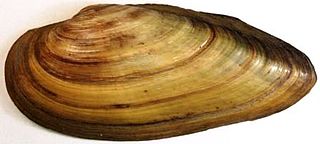
Unio is a genus of medium-sized freshwater mussels, aquatic bivalve mollusks in the family Unionidae, the river mussels. They are found throughout Europe, Africa, and the Middle East, with some species introduced to East Asia. Fossil species are also known from the Jurassic of North America.

Anodonta is a genus of freshwater mussels in the family Unionidae, the river mussels.
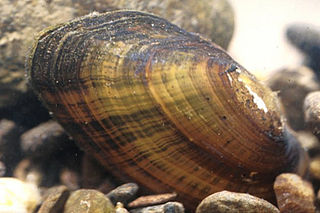
Alasmidonta is a genus of freshwater mussels, aquatic bivalve mollusks in the family Unionidae, the river mussels.

Anodontoides is a genus of freshwater mussels, an aquatic bivalve mollusk in the family Unionidae, the river mussels.
Elliptio congaraea, the Carolina slabshell, is a species of freshwater mussel, an aquatic bivalve mollusk in the family Unionidae, the river mussels.

The yellow lance, scientific name Elliptio lanceolata, is a species of freshwater mussel, an aquatic bivalve mollusk in the family Unionidae, the river mussels.
Elliptio nigella, the winged spike or recovery pearly mussel, is a species of freshwater mussel, an aquatic bivalve mollusk in the family Unionidae, the river mussels.
Elliptio producta, also known as the Atlantic spike, is a species of freshwater mussel, an aquatic bivalve mollusk in the family Unionidae, the river mussels. This species is endemic to the Eastern United States. It occurs on the Atlantic coast between the Savannah River and the Roanoke River basin. It may have been extirpated from the Ogeechee River system in Georgia. It lives in medium to large rivers on sand and gravel substrate.
Elliptio shepardiana,, the Altamaha lance, is a species of freshwater mussel, an aquatic bivalve mollusk in the family Unionidae, the river mussels, naiads or unionids.

Elliptio spinosa, the Altamaha spinymussel, is an endangered species of freshwater mussel in the family Unionidae. They live in southeastern Georgia in the Altamaha river and its tributaries. It is one of three species of North American spinymussels which are recognizable by their prominent spines. The Altamaha spinymussel genetically diverged from the other spinymussels 3.76 million years ago. This suggests that their spines evolved separately from the spines of other North American spinymussels. The Altamaha spinymussel is on the Endangered Species Act because of many threats with the most prominent threats being habitat loss, decrease in water quality, shrinking range, small population size, and vulnerability to disturbances.
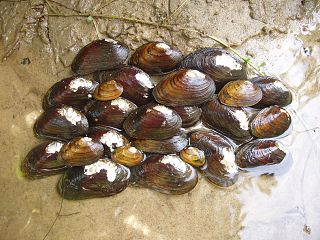
The James River spinymussel, also known as the Virginia spinymussel, is a species of freshwater mussel in the family Unionidae, the river mussels. This species is native to North Carolina, Virginia, and West Virginia in the United States. It is a federally listed endangered species of the United States. It was formerly placed in Pleurobema but in 2017, Perkins, Johnson & Gangloff placed the species into a new genus Parvaspina on account of genetic data and its lateral spines.
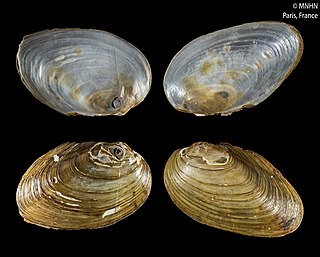
Pyganodon is a genus of freshwater mussels, aquatic bivalve mollusks in the subfamily Unioninae of the family Unionidae, the river mussels.

Sagittunio subrostratus, commonly referred to as the pondmussel or black pondmussel, is a species of freshwater mussel, an aquatic bivalve in the family Unionidae, the river mussels.
Uniomerus is a genus of freshwater mussels, aquatic bivalve mollusks in the family Unionidae, the river mussels.

Unio mancus is a species of freshwater mussel, an aquatic bivalve mollusk in the family Unionidae, the river mussels.
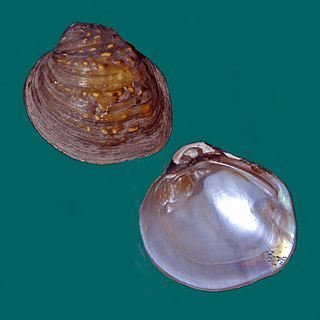
Rotundaria is a genus of freshwater mussels, aquatic bivalve mollusks in the family Unionidae, the river mussels.

Sagittunio is a genus of freshwater mussels, aquatic bivalve mollusks in the family Unionidae.

Ambleminae is a subfamily of freshwater mussel in the family Unionidae. They are found throughout much of eastern North America south to Central America, although fossils are also known from Siberia. Some species have also been introduced to East Asia. They are the most speciose radiation of the Unionidae, with more than 300 species.

Parvaspina is a genus of freshwater mussels, aquatic bivalve mollusks in the family Unionidae. It contains only two critically endangered species, both endemic to river basins in a small region of the southeastern United States.















